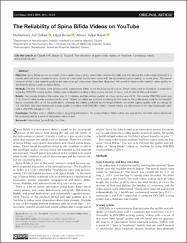| dc.contributor.author | Özbek, Muhammet Arif | |
| dc.contributor.author | Baran, Oğuz | |
| dc.date.accessioned | 2022-11-08T13:19:50Z | |
| dc.date.available | 2022-11-08T13:19:50Z | |
| dc.date.issued | 2022 | en_US |
| dc.identifier.citation | Özbek, M. A. ve Baran, O. (2022). The reliability of spina bifida videos on YouTube. Cerrahpaşa Medical Journal, 46(1), 56-60. http://doi.org/10.5152/cjm.2022.21059 | en_US |
| dc.identifier.issn | 2687-1904 | |
| dc.identifier.uri | http://doi.org/10.5152/cjm.2022.21059 | |
| dc.identifier.uri | https://hdl.handle.net/20.500.12511/9942 | |
| dc.description.abstract | Objective: Spina Bifida occurs as a result of incomplete closure of the neural tube between the 28th and 30th days of the embryological period. It is usually detected at the intrauterine time. Access to information has become easier with the development of technology in recent years. The easiest example of this is that patients apply to the internet to get information about their diagnoses. We aimed to examine the medical video quality on YouTube by doing a study on Spina Bifida. Methods: The first 50 videos were determined by typing Spina Bifida in the YouTube search engine. These videos were evaluated by 2 researchers using the DISCERN scoring system. Videos were analyzed according to their source, number of views, and number of likes and dislikes. Results: The average length of the videos was 11.2 minutes, and the average number of views per day was 28.24. The average DISCERN score was 1.78. Overall video quality was found to be “poor.” When the videos are analyzed according to their sources, the publications made by the hospital/ doctor constitute 44% of all the publications. Although the videos published by the hospital/doctor are of the highest quality with an average of 1.9 DISCERN, they were determined as poor quality according to the DISCERN criteria. Patient sharing was determined as the most inadequate video with a DISCERN average of 1.36. Conclusion: YouTube is not a reliable platform for getting information. The analyzed Spina Bifida videos also support this. YouTube videos should not be recommended as a medical information retrieval tool. | en_US |
| dc.language.iso | eng | en_US |
| dc.publisher | İstanbul University-Cerrahpaşa | en_US |
| dc.rights | info:eu-repo/semantics/openAccess | en_US |
| dc.rights | Attribution-NonCommercial 4.0 International | * |
| dc.rights.uri | https://creativecommons.org/licenses/by-nc/4.0/ | * |
| dc.subject | Information | en_US |
| dc.subject | Spina Bifida | en_US |
| dc.subject | YouTube | en_US |
| dc.title | The reliability of spina bifida videos on YouTube | en_US |
| dc.type | article | en_US |
| dc.relation.ispartof | Cerrahpaşa Medical Journal | en_US |
| dc.department | İstanbul Medipol Üniversitesi, Tıp Fakültesi, Cerrahi Tıp Bilimleri Bölümü, Beyin ve Sinir Cerrahisi Ana Bilim Dalı | en_US |
| dc.authorid | 0000-0002-1847-2562 | en_US |
| dc.identifier.volume | 46 | en_US |
| dc.identifier.issue | 1 | en_US |
| dc.identifier.startpage | 56 | en_US |
| dc.identifier.endpage | 60 | en_US |
| dc.relation.publicationcategory | Makale - Ulusal Hakemli Dergi - Kurum Öğretim Elemanı | en_US |
| dc.identifier.doi | 10.5152/cjm.2022.21059 | en_US |
| dc.institutionauthor | Özbek, Muhammet Arif | |
| dc.identifier.trdizinid | 526133 | en_US |



















